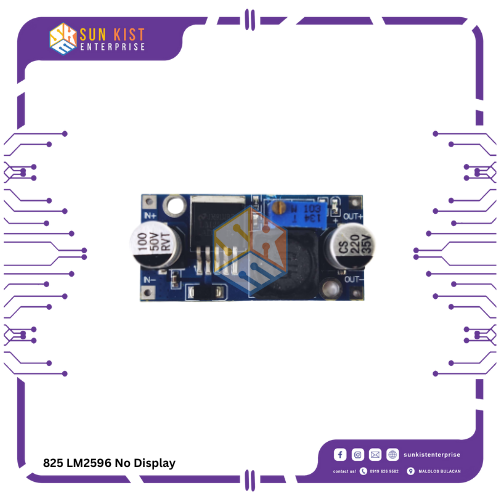Description
If an LM2596 voltage regulator module is not displaying any output voltage or showing no display, there could be several possible reasons for this issue. Here are some troubleshooting steps to help you identify and resolve the problem:
1. **Check Input Voltage:** Make sure the LM2596 module is receiving the correct input voltage within its specified operating range. The LM2596 typically operates with an input voltage range of 4.5V to 40V, but the exact range can vary depending on the specific module you’re using.
2. **Output Voltage Setting:** Verify that the LM2596 is correctly configured for the desired output voltage. Use a multimeter to measure the output voltage and ensure it matches your intended setting.
3. **Connection Integrity:** Check the connections between the input voltage source, LM2596 module, and the load (the device or circuit you’re powering). Loose or improper connections can result in no output.
4. **Load Current:** Ensure that there is a load connected to the LM2596 module. Some voltage regulators require a minimum load to regulate correctly. If there’s no load, the output voltage may not be stable.
5. **Output Current Limit:** The LM2596 has a specified output current limit. If the load current exceeds this limit, the module may not provide a stable output voltage. Make sure the load current is within the module’s specified range.
6. **Overheating:** If the LM2596 module is getting excessively hot, it may shut down to protect itself. Ensure that it has proper heat dissipation, and consider using a heatsink if needed.
7. **Faulty Module:** It’s possible that the LM2596 module is defective. Test the module by replacing it with a known working one to see if the problem persists.
8. **Polarity:** Confirm that you have the correct polarity for the input voltage and output voltage connections. Reversing the connections can damage the module.
9. **Input Voltage Stability:** Ensure that the input voltage is stable and free from excessive voltage fluctuations or noise. Instability in the input voltage can affect the LM2596’s output.
10. **Short Circuits:** Check for any short circuits on the LM2596 module, the input voltage source, or the load. Shorts can prevent the module from functioning correctly.
11. **Input Voltage Transients:** Protect the module from voltage spikes and transients by adding input voltage protection components if necessary.
12. **Capacitors:** The LM2596 module may require input and output capacitors for stability. Make sure these capacitors are properly installed and have the correct values.
If you’ve checked all these aspects and the LM2596 module is still not functioning, it’s possible that the module is faulty or damaged, and you may need to replace it. Additionally, consulting the module’s datasheet and following the manufacturer’s recommendations for proper setup and usage can help ensure correct operation.






Reviews
There are no reviews yet.